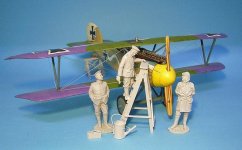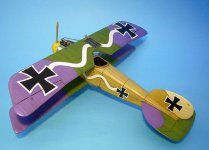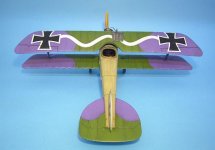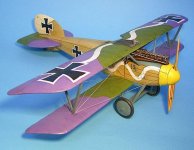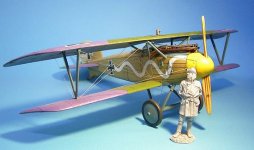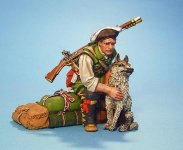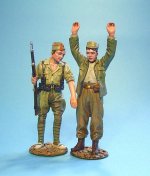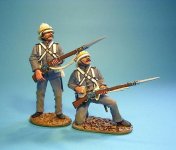Good morning from a wet and rainy Northern California, where we are having our first serious winter storm, except it is supposed to be Spring.
It was great to meet many of you at the West Coaster Show and hope to see you all in Chicago.
As always we hope you like the new releases. You have got to love the Albatross and also the Raid on St Francis, still one of my all time favorite collections. We will have the new releases on the website, later this morning.
www.sierratoysoldier.com
As always hope you like them as much as I do.
Mike
Sierra Toy Soldier Company
KNIGHTS OF THE SKIES
The Albatros D.III was a biplane fighter aircraft used by the Imperial German Army Air Service (Luftstreitkräfte) and the Austro-Hungarian Air Service (Luftfahrtruppen) during World War I. The D.III was flown by many top German aces, including Manfred von Richthofen, Ernst Udet, Erich Löwenhardt, Kurt Wolff, and Karl Emil Schäfer. It was the pre-eminent fighter during the period of German aerial dominance known as "Bloody April" 1917.
Albatros built approximately 500 D.III aircraft at its Johannisthal factory.
In the spring of 1917, D.III production shifted to Albatros' subsidiary, Ostdeutsche Albatros Werke (OAW), to permit Albatros to concentrate on development and production of the D.V.
Between April and August 1917, Idflieg issued five separate orders for a total of 840 D.IIIs. The OAW variant underwent its Typenprüfung in June 1916. Production commenced at the Schneidemühl factory in June and continued through December 1917.
The OAW product were often distinguished by the wings being camouflaged in lilac and green, and by their larger, rounded rudders.Peak service was in November 1917, with 446 aircraft on the Western Front. The D.III did not disappear with the end of production, however. It remained in frontline service well into 1918.
As of 31 August 1918, 54 D.III aircraft remained on the Western Front.
This aircraft has been identified as the machine flown by Ltn. Erich Lowenhardt of Jasta 10. This DIII had a white wavy “snake –line” applied to the fuselage sides and top surface of the upper wing. The standard yellow Jasta 10 nose colour was also applied, as well as a small personal number “15”.
ACE-07
Knights Of The Skies, ALBATROS DIII O.A.W, Jasta 10, Marcke, September 1917, Flown by Ltn. Erich Lowenhardt,
(1pc)
Retail us$235
THE RAID ON ST. FRANCIS
Captain William Stark, was the elder brother of Captain John Stark (who was to become one of the outstanding Major Generals in the American Revolution).
William Stark apparently found the dog while on a hunting trip north. A French officer was beating the dog and Stark intervened. A fierce duel ensued between the French officer and Stark, which was won by the ranger. The dog gladly attached himself to his new champion.
Stark was to call him Sergeant Beau de Bien but other Rangers were to shorten it to “Beaubien”.
At one point throughout their history, Stark entered the wolf/dog into the official Ranger muster roll to draw a Sergeant's rations and pay. Therefore he became known simply as “The Sergeant”.
It has been said that Sergeant Beaubien scared off his share of the enemy, and was well deserving of his pay. It was also reported that he lived to a ripe old age.
RR-04
THE RAID ON ST. FRANCIS, Captain William Stark and Sergeant Beaubien,
(2pcs)
Retail us$48
THE FIRST SUDAN WAR 1884-1885
This is the second release of the Royal Marine Light Infantry, The sets will follow a similar pattern to the previously released Gordon Highlanders.
RML-01
THE FIRST SUDAN WAR 1884-1885 ROYAL MARINE LIGHT INFANTRY
2 Figures Loading
(2pcs)
Retail us$68
THE SPANISH CIVIL WAR
NAT-04
THE SPANISH CIVIL WAR
The Prisoner
(2pcs)
Retail us$68
The Spanish Legion was modelled on the French Foreign Legion. Its purpose was to provide a corps of professional troops to fight in Spain's colonial campaigns in North Africa, in place of conscript troops that were proving ineffective.
Under the leadership of Lieutenant Colonel Juan Yagüe the Army of Africa played an important part in the Spanish Civil War on the Nationalist side. The professionalism of both the Legion and the Regulares gave Franco's Nationalists a significant initial advantage over the less well trained Republican forces.
Both the Nationalists and the loyalist Republican troops used foreign volunteers. In the case of the Republicans the International Brigades were organized, recruiting over 40,000 people. These proved to be the elite of the Republican forces and as such were stationed at the toughest sectors, and were often involved in the most desperate attacks.
TRAVEL AND SHOWS FOR 2012
JOHN WILL BE AT THE LONDON TOY SOLDIER SHOW SATURDAY 31st MARCH 2012
Hope you enjoyed the new releases.
Mike
Sierra Toy Soldier Company
It was great to meet many of you at the West Coaster Show and hope to see you all in Chicago.
As always we hope you like the new releases. You have got to love the Albatross and also the Raid on St Francis, still one of my all time favorite collections. We will have the new releases on the website, later this morning.
www.sierratoysoldier.com
As always hope you like them as much as I do.
Mike
Sierra Toy Soldier Company
KNIGHTS OF THE SKIES
The Albatros D.III was a biplane fighter aircraft used by the Imperial German Army Air Service (Luftstreitkräfte) and the Austro-Hungarian Air Service (Luftfahrtruppen) during World War I. The D.III was flown by many top German aces, including Manfred von Richthofen, Ernst Udet, Erich Löwenhardt, Kurt Wolff, and Karl Emil Schäfer. It was the pre-eminent fighter during the period of German aerial dominance known as "Bloody April" 1917.
Albatros built approximately 500 D.III aircraft at its Johannisthal factory.
In the spring of 1917, D.III production shifted to Albatros' subsidiary, Ostdeutsche Albatros Werke (OAW), to permit Albatros to concentrate on development and production of the D.V.
Between April and August 1917, Idflieg issued five separate orders for a total of 840 D.IIIs. The OAW variant underwent its Typenprüfung in June 1916. Production commenced at the Schneidemühl factory in June and continued through December 1917.
The OAW product were often distinguished by the wings being camouflaged in lilac and green, and by their larger, rounded rudders.Peak service was in November 1917, with 446 aircraft on the Western Front. The D.III did not disappear with the end of production, however. It remained in frontline service well into 1918.
As of 31 August 1918, 54 D.III aircraft remained on the Western Front.
This aircraft has been identified as the machine flown by Ltn. Erich Lowenhardt of Jasta 10. This DIII had a white wavy “snake –line” applied to the fuselage sides and top surface of the upper wing. The standard yellow Jasta 10 nose colour was also applied, as well as a small personal number “15”.
ACE-07
Knights Of The Skies, ALBATROS DIII O.A.W, Jasta 10, Marcke, September 1917, Flown by Ltn. Erich Lowenhardt,
(1pc)
Retail us$235
THE RAID ON ST. FRANCIS
Captain William Stark, was the elder brother of Captain John Stark (who was to become one of the outstanding Major Generals in the American Revolution).
William Stark apparently found the dog while on a hunting trip north. A French officer was beating the dog and Stark intervened. A fierce duel ensued between the French officer and Stark, which was won by the ranger. The dog gladly attached himself to his new champion.
Stark was to call him Sergeant Beau de Bien but other Rangers were to shorten it to “Beaubien”.
At one point throughout their history, Stark entered the wolf/dog into the official Ranger muster roll to draw a Sergeant's rations and pay. Therefore he became known simply as “The Sergeant”.
It has been said that Sergeant Beaubien scared off his share of the enemy, and was well deserving of his pay. It was also reported that he lived to a ripe old age.
RR-04
THE RAID ON ST. FRANCIS, Captain William Stark and Sergeant Beaubien,
(2pcs)
Retail us$48
THE FIRST SUDAN WAR 1884-1885
This is the second release of the Royal Marine Light Infantry, The sets will follow a similar pattern to the previously released Gordon Highlanders.
RML-01
THE FIRST SUDAN WAR 1884-1885 ROYAL MARINE LIGHT INFANTRY
2 Figures Loading
(2pcs)
Retail us$68
THE SPANISH CIVIL WAR
NAT-04
THE SPANISH CIVIL WAR
The Prisoner
(2pcs)
Retail us$68
The Spanish Legion was modelled on the French Foreign Legion. Its purpose was to provide a corps of professional troops to fight in Spain's colonial campaigns in North Africa, in place of conscript troops that were proving ineffective.
Under the leadership of Lieutenant Colonel Juan Yagüe the Army of Africa played an important part in the Spanish Civil War on the Nationalist side. The professionalism of both the Legion and the Regulares gave Franco's Nationalists a significant initial advantage over the less well trained Republican forces.
Both the Nationalists and the loyalist Republican troops used foreign volunteers. In the case of the Republicans the International Brigades were organized, recruiting over 40,000 people. These proved to be the elite of the Republican forces and as such were stationed at the toughest sectors, and were often involved in the most desperate attacks.
TRAVEL AND SHOWS FOR 2012
JOHN WILL BE AT THE LONDON TOY SOLDIER SHOW SATURDAY 31st MARCH 2012
Hope you enjoyed the new releases.
Mike
Sierra Toy Soldier Company


